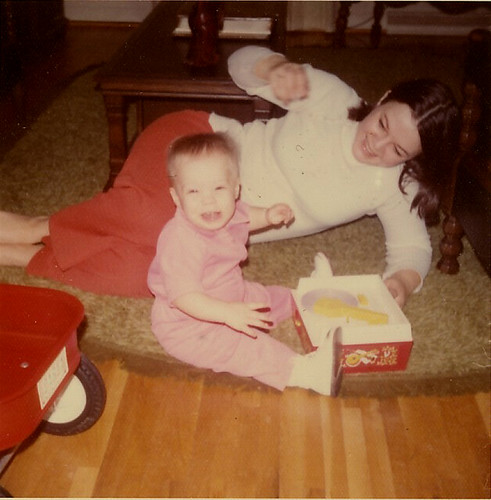How is it possible then, that something so innate seems lost in older children and adults? In most cases, I don't think this rhythmic sense is lost, but that it lacks internalization of the beat in a way that coordinates with movement. Some researchers believe the neural pathways for learning music are set within the first two years of life. As parents and teachers we can strengthen these pathways in a variety of ways. Here are some guidelines and activities to help you develop your child's sense of rhythm through the first 12-18 months.
Rhythmic Comfort. Comfort your baby in all the ways I mentioned before: bouncing, rocking, patting, swinging, and dancing with your baby. You will be doing this anyway, so add "practiced developing baby's sense of rhythm" to your done list each day. It's always nice to have extra things on that list.
Bouncing, Tapping, and Clapping Rhymes. Bouncing rhymes are great for developing rhythm and language. Before baby has good head control, carefully bounce her laying across your lap, or on her back with your arms supporting her head. When she is 3-4 months old and has good head control, she can sit up on your lap. You may be familiar with some bouncing rhymes. Here is one of my favorites from childhood:
Trot little horsey
Trot to town
Trot little horsey
Don't fall down.
There are a million variations on this, and they are fun for babies starting around four months old. They can sit up in your lap to bounce and drop down between your knees on the last line. Sometimes I delay the drop when I know they are expecting it just to get a bigger laugh. Here's another one I remember:
To market, to market
To buy a fat pig
Home again, home again
Jiggety-jig.
To market, to market
To buy a fat hog
Home again, home again
Jiggety-jog.
Dr. John Feierabend, a leading expert in children's music and movement development, collected rhymes like these through interviews. He found that 100 years ago families had a vast repertoire of rhymes and games meant to be played with a baby on your lap. Most of these have been lost over time, and our generation remembers only a few. His fascinating curriculum based on this discovery can be read about here. I highly recommend the read.
So, what are the rhymes that have survived? How about "This Little Piggy Went to Market"? Or "Pat-a-cake, pat-a-cake, baker's man"? Dr. Feierabend discusses and gives examples of more rhymes meant for wiggling fingers and toes, tapping & clapping, and tickling the baby in this sampler of his full collection. Here is another great pdf collection from a Pierce County Library System. It includes rhymes in English, Spanish, Russian, and Korean. Some of the lap games from this article at Today's Parent were familiar to me also.
Sing to your baby. Sing simple songs. Sing songs you love. Sing lullabies. Sing even if you think you can't sing. Baby doesn't know the difference, but he needs needs to know that rhythm can be kept in the voice and in the body. As you sing, keep the rhythm as you sway, dance, or pat your little one.
Listen to music. A variety of rhythms is best. Dance while you listen. Dance with baby while you listen. Infants and toddlers can move more accurately to a quick beat than a slow one, so consider keeping it uptempo unless it's bedtime or naptime.
Play or sing to their beat. When baby is doing something rhythmic like bouncing himself in a chair or jumping in a doorway, sing or play a song (or chant a rhyme) to the beat they have set. If they stop moving, stop what you are doing until they continue. You could also do this while the baby is in a swing with a beat you set yourself.
As you do these activities with your baby, enjoy them! You'll have happy memories, and your child will develop not only a sense of rhythm, but language skills, and a stronger parent-child bond.
---
Do you have a favorite lap rhyme from childhood? Have more ideas on connecting babies with rhythm? I'd love to read them in the comments!
If you're interested in the science behind babies' perception of rhythm. Here are some links:
Newborn infants detect the beat in music - Proceedings of the National Academy of Sciences of the United States of America
Pregnancy and Baby summary of the research
USA Today summary of the research





No comments:
Post a Comment